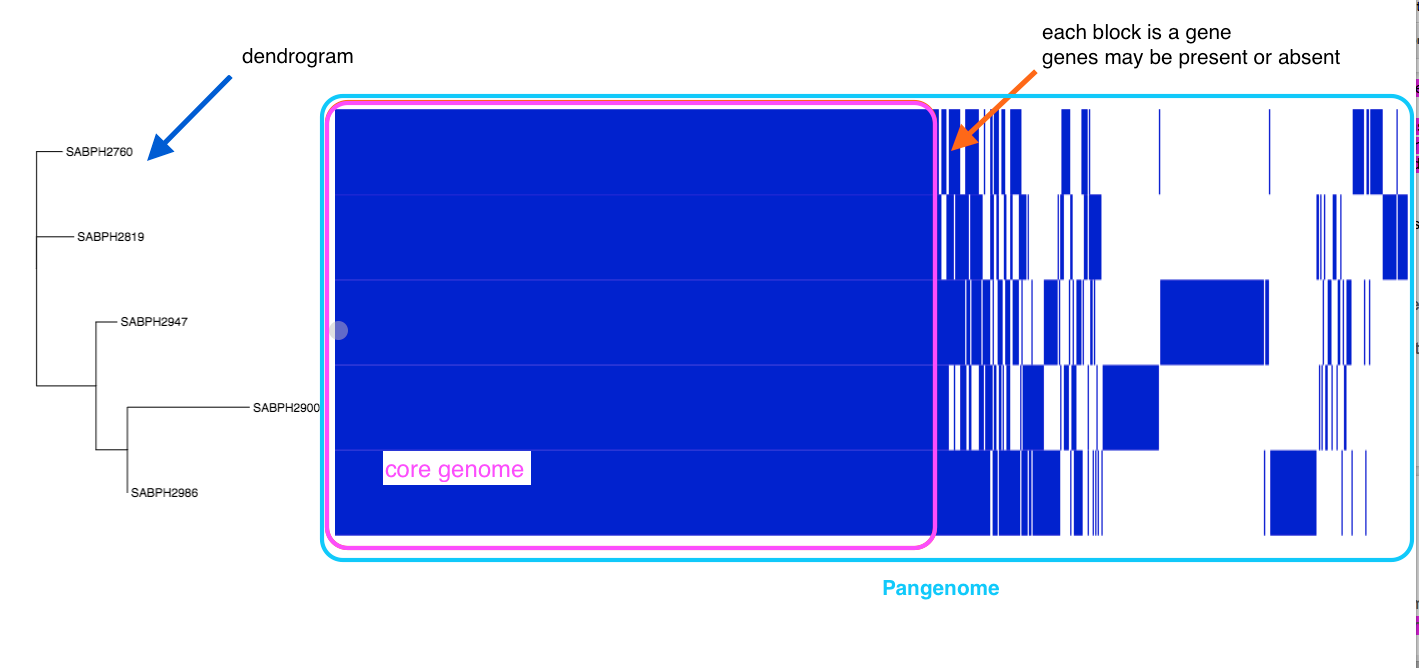Find pan-genomes using Roary (using the commandline)
A concept in comparative microbial genomics is core and pan genomes. If we analyse DNA from several bacterial strains, we may want to know which genes they have in common and which are unique to some strains.
-
The core genome is the group of genes shared by all strains in the clade of interest. Gene sequences are similar but not necessarily identical. “Core genome SNPs” are those SNPs found in the genes in the core genome; i.e. at a particular site, the nucleotide varies. We can use these SNPs to infer relationships between the strains.
-
The accessory genome is the group of genes that are not in all the strains. These genes may be in one or more strain.
-
The pan genome is the sum of the core and accessory genomes. That is, a combination of all the genes that are found in the clade of interest.
Bacteria can horizontally-transfer genes to other bacteria via plasmids, and so their accessory genome can be large relative to those of eurkaryotes. Bacterial accessory genomes often house genes for drug resistance.
This tutorial demonstrates how to calculate the pan and core genomes of a set of input bacterial samples, using the tool Roary.
Get data
Input:
- annotated genome in GFF3 format, per sample (e.g. output from Prokka)
- samples must be from same species
Our data:
- Five strains of Staphylococcus aureus, in .gff format.
Run
Run roary
roary -e --mafft -p 8 *.gff
-e --mafftaligns the core genes using the tool MAFFT-p 8uses 8 threads
What does Roary do
- converts coding sequences into protein sequences
- clustered these protein sequences by several methods
- further refines clusters into orthologous genes
- for each sample, determines if gene is present/absent: produces
gene_presence_absence.csv - uses this gene p/a information to build a tree, using FastTree: produces
accessory_binary_genes.fa.newick - overall, calculates number of genes that are shared, and unique: produces
summary_statistics.txt - aligns the core genes (if option used, as above) for downstream analyses
Output
Core and pan genes
Open the summary file:
less summary_statistics.txt
This shows a table of counts of shared genes (core genome) and total genes (pan genome).

What are the core genes?
query_pan_genome -a intersection -o core_genome_results *.gff
What are the accessory genes?
query_pan_genome -a complement -o accessory_genome_results *.gff
What are the pan genes?
query_pan_genome -a union -o pan_genome_results *.gff
View: e.g.
less core_genome_results | column -t
Gene presence/absence
Transfer the file
- Search for the gene that confers methicillin resistance. It is only found in some of the strains.
Vizualize with Phandango
Copy these files to your local computer:
accessory_binary_genes.fa.newick gene_presence_absence.csv
Go to http://phandango.net
- drag and drop the two files onto the landing page.
- view the tree of samples and their core and pan genomes

Links
- Roary: https://sanger-pathogens.github.io/Roary/
- Roary publication: http://bioinformatics.oxfordjournals.org/content/31/22/3691